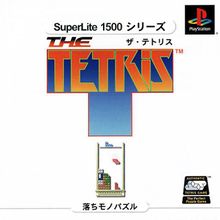SuperLite 1500 Series: The Tetris
| SuperLite 1500 Series: The Tetris | |
|---|---|
 | |
| Developer(s) | Success |
| Publisher(s) | Success |
| Platform(s) | PlayStation |
| Release |
|
| Gameplay info | |
| Next pieces | 1 |
| Playfield size | 10 × 20, with 3 lines in vanish zone visible. |
| Hold piece | No |
| Hard drop | No |
| Rotation system | Tetris DX rotation system |
SuperLite 1500 Series: The Tetris is a member of the SuperLite 1500 series of budget-priced games for the PlayStation published by Success. The company would later publish Tetris Kiwamemichi as part of their SuperLite 2000 series.
Modes and Gameplay
1 Player Mode
The player can start at level 0, 5, 10, 15, 20, 25 or 30 by default, with successive 5-level sections being unlocked after clearing them in 1-player mode. Level increases every 10 lines and caps at 99.
The player is allowed to continue if they game over, at which point the player will restart at the beginning of their current 5-level section with score reset.
The background changes every level, and continues to change every 10 lines after level 99. There are a total of 140 backgrounds, which loop; each set of 5 has a common theme.
Speeds
- Soft drop: 1G
- Lock delay: 30 frames
- Soft dropped pieces do not lock immediately; instead, holding down the button will cause the lock delay timer to drain 4 times as fast.
- ARE: 0 frames (1G or below) / 20-30 frames (2G and above)
- Line clear delay: ~17 frames
- DAS: 10 frames, 30 Hz (1/4G or below) / 60 Hz (1/3G and above)
Levels
Note that the speed decreases after every 5-level section, with the exception of level 95.
| Level | Gravity (G) | Level | Gravity (G) | Level | Gravity (G) | Level | Gravity (G) |
|---|---|---|---|---|---|---|---|
| 0 | 1/120 | 25 | 1/35 | 50 | 1/30 | 75 | 1/5 |
| 1 | 1/80 | 26 | 1/15 | 51 | 1/15 | 76 | 2 |
| 2 | 1/55 | 27 | 1/10 | 52 | 1/10 | 77 | 4 |
| 3 | 1/40 | 28 | 1/5 | 53 | 1/5 | 78 | 5 |
| 4 | 1/30 | 29 | 1/3 | 54 | 1/3 | 79 | 7 |
| 5 | 1/60 | 30 | 1/35 | 55 | 1/15 | 80 | 1/3 |
| 6 | 1/40 | 31 | 1/10 | 56 | 1/3 | 81 | 2 |
| 7 | 1/25 | 32 | 1/7 | 57 | 2 | 82 | 4 |
| 8 | 1/18 | 33 | 1/4 | 58 | 3 | 83 | 6 |
| 9 | 1/15 | 34 | 1/2 | 59 | 4 | 84 | 7 |
| 10 | 1/60 | 35 | 1/20 | 60 | 1/10 | 85 | 1/3 |
| 11 | 1/35 | 36 | 1/10 | 61 | 1/3 | 86 | 3 |
| 12 | 1/20 | 37 | 1/5 | 62 | 2 | 87 | 5 |
| 13 | 1/12 | 38 | 1/2 | 63 | 4 | 88 | 7 |
| 14 | 1/9 | 39 | 1 | 64 | 5 | 89 | 8 |
| 15 | 1/40 | 40 | 1/20 | 65 | 1/10 | 90 | 2 |
| 16 | 1/20 | 41 | 1/5 | 66 | 1/2 | 91 | 4 |
| 17 | 1/15 | 42 | 1/2 | 67 | 2 | 92 | 5 |
| 18 | 1/10 | 43 | 1 | 68 | 4 | 93 | 7 |
| 19 | 1/7 | 44 | 2 | 69 | 5 | 94 | 8 |
| 20 | 1/40 | 45 | 1/15 | 70 | 1/5 | 95-99 | 9 |
| 21 | 1/15 | 46 | 1/4 | 71 | 1 | ||
| 22 | 1/10 | 47 | 1 | 72 | 3 | ||
| 23 | 1/7 | 48 | 2 | 73 | 5 | ||
| 24 | 1/5 | 49 | 3 | 74 | 6 |
Scoring
Lines are scored the same way as in the NES version. However, the game also counts All Clears, awarding 1,000,000 points per clear (regardless of level).
Randomiser
Strict 1 history i.e. no two consecutive pieces will be the same.
2 Player Mode
2 player mode. Each player can choose the following options:
- Level: 0, 10, 20, 30, 40 and "SP" (99).
- Height: 0 to 5, corresponding to 0, 3, 6, 8, 10 or 12 rows of starting random garbage.
- "Rising" (garbage type): Easy = 1 hole and mostly aligned (changing every 9 rows), Normal = 4 hole and random, Hard = 7 hole and random.
Both players have the same piece sequence but independent starting garbage.
Oh, and Utada Hikaru is pretty good at it. :)
Garbage is based on the 0/1/2/4 line system. All Clears double the amount of garbage.
Other gameplay notes
Game over is lock out based. The vanish zone is visible in this game, and any piece spawned in it will overwrite existing blocks in it. The ceiling of the vanish zone is solid.
Rotation system is the same as in Tetris DX but with different spawn orientations.
An option screen without any real options except mono/stereo, vibration, ranking and backup functions.
The music is pretty bad as well, though it does have an interesting Korobeiniki arrangement. Music can be changed by pausing and pressing Select.
Score maxes out at 99,999,999 points, lines at 999, and all clears at 99.
Links
| |||||||||||

